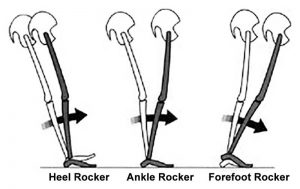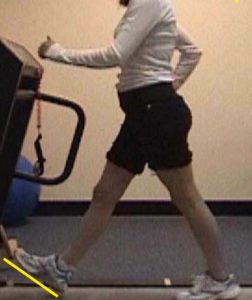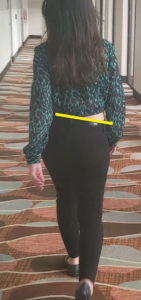Gait deviations clustering gait deviations – injury – new data

In a previous blog article, I discussed the question “Is there a gait deviation or cluster of gait deviations which is common across musculoskeletal pain syndromes?” The consensus is currently there is no definitive evidence suggesting one gait deviation or cluster of gait deviations occurs more frequently or is more important than another. More research is needed.
Well, additional research has been published. In a well-designed study by Bart Dingenen and colleagues, the investigators concluded a cluster of gait deviations is related to injuries of different regions of the lower extremity.
They identified a clustering of gait deviations subclassified into two subgroups.
One subgroup shows greater foot inclination and lower leg inclination angle at initial contact. This subgroup shows overstriding or too long a step/stride.

Example of too long a step/stride
The study by Dingenen and colleagues looked at recreational runners. We might assume that the analysis and conclusions may be applicable to walking. Recognizing assumptions needed to be tested.
This movement deviation of too long a step/stride has a higher proportion of lower leg shin injuries and fewer hip and foot injuries.
The other subgroup shows a greater pelvic drop, and knee flexion during midstance. This subgroup shows as dynamic valgus or diminished core pelvic/hip girdle instability.

Example of excessive hip/pelvic movement walking – the “catwalk”
This movement deviation of excessive pelvic hip motion has a higher proportion of hip injuries such as gluteal tendinopathy, and knee injuries, and less lower leg and foot injuries.
It is interesting to note that neither of the two subgroups identified by Dingenen and colleagues related to a higher proportion of foot injuries.
A deeper dive into the methodology of the study by Dingenen and colleagues may show why. The list of gait deviations the investigators observed occurred only during the first two periods of stance. They observed movements at heel rocker (initial foot contact) and during ankle rocker). They did not measure movements during the period of terminal stance (forefoot rocker).

The stance phase of gait is differentiated into 3 distinct periods: 1st foot strike, initial contact, shock absorption phase; 2nd is loading response, mid-stance, stability; 3rd terminal stance. heel off, toe-off. propulsive, energy conservation
I would argue the 3rd period of forefoot rocker is particularly challenging for the foot.
The 3rd period of stance is particularly challenging for the muscles in the foot. The intrinsic muscles of the foot are shortening to support and raise the longitudinal arch of the foot at the same time they are performing a lengthening muscle contraction (eccentric) to allow the toes to flex. This a very conflicted time for the muscles in the foot.

Example of forefoot rocker right foot.
The movement deviations that can be observed during the forefoot rocker period stance that may be associated with injuries to the foot are early heel off, late heel off, excessive dorsiflexion of the big toe joint, or limited dorsiflexion of the big toe joint.
Gait deviations can be a contributing factor to the development of injuries. Gait deviations are multiple, different, and similar. Clustering of gait deviations based on the period of stance phase may be related to increased risk of regional joint injuries.
Summary – movement deviations during the period of stance potentially related to lower extremity injury.
| Period of stance | Potential movement deviation | Regional joint injury |
| Heel rocker | Too long a step | ↑ risk of shin injury |
| Ankle rocker | Contralateral pelvic drop | ↑ risk of hip knee injury |
| Forefoot rocker | Early or delayed dorsiflexion | ↑ risk of foot injury |
The above is a hypothesis that needs validation. Case studies and studies like the one by Dingenen and colleagues can provide validation.
The relationship of a cluster of gait deviations to injuries should be stronger relationship than the relationship between a single gait deviation and injury. The strength of the relationship between a cluster of deviations and injury is stronger if the clusters are mutually exclusive. I suspect there are situations when the three subclassifications above may be mutually exclusive. However, there are likely situations when it is not mutually exclusive, that is, movement deviations occur during more than one period of stance.
However, despite the potential shortcoming of the clustering or subclassification movement deviations, I believe it can provide a starting point to problem-solving walking/running repetitive use injuries which are complex and with multifaceted etiological factors.
The information on this website is not intended or implied to be a substitute for professional medical advice, diagnosis, or treatment. You are encouraged to perform additional research regarding any information contained available through this website with other sources and consult with your physician.
Damien Howell Physical Therapy – 804-647-9499 – Fax: 866-879-8591 At-Home, At Office, At Fitness Facility – I come to you, I do home visits Damien@damienhowellpt.com
